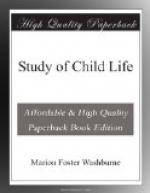Besides these occupations which are truly part of the business of life come any number of other occupations—a sort of a cross between real play and steady work, what teachers call “busy work”—and here the suggestions of the Kindergarten may be of practical value to the mother. For instance, weaving, already referred to, may keep an active child interested and quiet for considerable periods of time. Besides the regular weaving mats of paper, to be had from any Kindergarten supply store, wide grasses and rushes may be braided into mats, raffia and rattan may be woven into baskets, and strips of cloth woven into iron-holders. A visit to any neighboring Kindergarten will acquaint the mother with a number of useful, simple objects that can be woven by a child. Whatever he weaves or whatever he makes should be applied to some useful purpose, not merely thrown away; and while it is true that a conscientious desire to live up to this rule often results in a considerable clutter of flimsy and rather undesirable objects about the house, still, ways may be devised for slowly retiring the oldest of them from view, and disposing of others among patient relatives.
[Sidenote: Sewing]
Sewing is another occupation ranch used in the Kindergarten as well as in the home. Beginning with the simple stringing of large wooden beads upon shoe-strings, it passes on to sewing on buttons, and sewing doll clothes to the making of real clothing. This last in its simplest form can be begun sooner than most parents suppose, especially if the child is taught the use of the sewing machine. There is really no reason why a child, say six years old, should not learn to sew upon the machine. His interest in machinery is keen at this period, and two or three lessons are usually sufficient to teach him enough about the mechanism to keep him from injuring it. Once he has learned to sew upon the machine, he may be given sheets and towels to hem, and even sew up the seams of larger and more complex articles. He will soon be able to make aprons for himself and his sisters and mother. Toy sewing machines are now sold which are really useful playthings, and on which the child can manufacture a number of small articles. Those run by a treadle are preferable to those run by a hand crank, because they leave the child’s hands free to guide the work.
[Sidenote: Drawing Cutting Pasting]
Drawing, painting, cutting and pasting are excellent occupations for children. A large black-board is a useful addition to the nursery furnishings, but the children should be required to wash it off with a damp cloth, instead of using the eraser furnished for the purpose, as the chalk dust gets into the room and fills the children’s lungs. Plenty of soft pencils and crayons, also large sheets of inexpensive drawing paper, should be at hand upon a low table so that they can draw the large free outlines which best develop their skill, whenever the impulse moves them. If they have also blunt scissors for cutting all sorts of colored papers and a bottle of innocuous library paste, they will be able to amuse themselves at almost any time.




